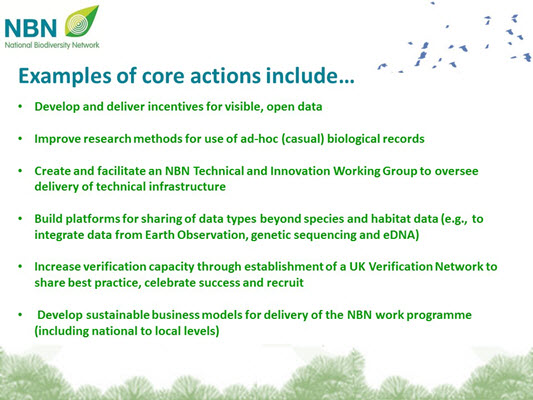NFRB & BES Macroecology Special Interest Group joint conference 2015
Conference report by Secretariat for the NBN
New and familiar faces arrived at Sheffield University for the NFBR 2015 conference, this year a joint event with the BES Macroecology Special Interest Group. The conference programme included a series of technology demonstrations, an afternoon of workshops and a wide range of talks, including five minute quick fire talks so we were all kept on our toes!
An inspiring first morning was spent discussing and exploring cutting edge tools and technology for collecting and interpreting biological records. It was clear that technology, especially when embedded in smartphones, will make recording accessible to almost everyone and is advancing at a phenomenal rate. We can all now collect, and in some cases help analyse data via our smartphones and tablets, even from the back of a conference hall….
Oh dear, @ProfKateJones has got me addicted to @InstantWild #NFBR15 look a giraffe! pic.twitter.com/W5e9vQ4yK3
— Tom August (@TomAugust85) April 24, 2015
But we need to be mindful of the risks that come from these new technologies. This includes the quality of the data, the potential to overload the verification network and investment in technologies that may move on faster than the rate we can adopt and implement them. It is certainly a great time to be a recorder.
As part of this session the NBN Trust ran a workshop to demonstrate and discuss the future direction of the NBN Trust’s data infrastructure, offering an opportunity for delegates to explore the demo site for the UK Wildlife Portal – you can see more on this in a separate article here.
Afternoon workshops covered extremely hot topics including Open Data, DNA techniques and biological recording the role of Local Environmental Record Centres in supporting recording and research.
It's really hard to decide which open space workshop to attend this pm @_NFBR #NFBR15 Lots of fantastic topics pic.twitter.com/8FsjoiWHZm
— NBN Trust (@NBNTrust) April 23, 2015
Many suggestions from these workshops have already been captured in the NBN Action Plan which outlines the objectives and priority actions for the NBN over the next five years and which is being consulted on now (see slide below and separate article).
Wondering how we can achieve @DavidRoyBRC manifesto for the future? Identify your role in the NBNActionPlan #NFBR15 pic.twitter.com/s3gtYnaeFp
— NBN Trust (@NBNTrust) April 24, 2015

The second day focussed on techniques used in biological recording across the UK, both on a local and national scale. Speakers included a keynote address from Kate Jones (University College London and Bat Conservation Trust) demonstrating a range of novel technologies for the future, a fascinating talk from Lois Mayhew (Alderney Wildlife Trust) discussing the challenges and opportunities of running a local environmental record centre in the Channel Isles, and Mark Spencer (Natural History Museum) shedding light on how scientifically robust data held in natural history collections can help answer questions on environmental change.
Key messages from the day were:
? novel technologies are helping advance our understanding of the world around us and engage new cohorts of biological recorders
? through increasing the availability of our data holdings, and link these with other datasets we can help enhance environmental niche modelling, and other innovative predictive techniques
? millions of records across the UK are locked up in historic archives including herbaria and museum specimens, journals and notebooks. There is an increasing need to mobilise these records
? there is a need to increase collaboration between the biological recording community and technology research sector to develop robust and useful applications to help further our knowledge of the world around us
The NFBR/BES Conference 2015 was an inspiring event. The Secretariat of the NBN is looking forward to working with NFBR (and all involved with the conference) to start embedding new technologies into our work. It is also vital that we all identify the leads, or participants in delivering the core work of the NBN Action Plan, and that we collaborate to pave a new future for biological recording.
